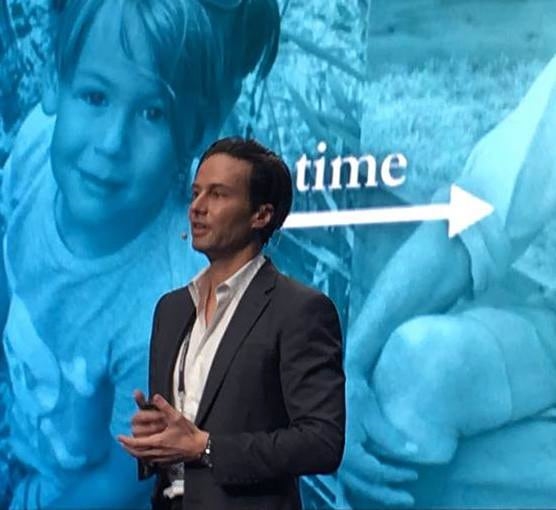Can Secret To Staying Forever Young Be As Simple As Flicking A Switch?
“These are siblings—-born within seconds of each other,” Ned David says of the two mice he shows in a video flashing on the wall. In mouse years, they were both around 70. One was frail and blind with its fur falling out, hunched against the wall; the other limber and scampering about.
The difference: Researches had cleared one mouse of senescent cells, which appear only in older mammals and are responsible for many of the hallmarks of aging: blindness, joint pain, and bone deterioration. The existence of these cells, says David, cofounder of UNITY Biotechnology, and the ability of science and medicine to treat them, may be the key to tackling the most difficult aspects of getting old.

“We’ve long labored under the idea that aging is an inevitability–a process over which we have no control,” David tells a crowd gathered at a South By Southwest panel last weekend. That, David says, is not true. “Aging has control knobs,” David says, “and we’re learning how to turn these knobs in increasingly safe ways.” And the science, tech, and businesses communities are waking up to the opportunities inherent in reducing the pain associated with aging.
When we’re young, David says, our cells naturally divide—this constant renewal is what keeps us youthful and what, for instance, maintains wrinkle-free skin and supple joints. As we age, he says, our cells essentially get exhausted and “pull the emergency brake” to stop dividing. That phenomenon is called senescence. And these senescent cells don’t just represent the end of youth for that particular cell–they also secrete toxins into the surrounding cells, which begin to break down. That’s why you see the tissue in between joints erode in older mammals, and bones begin to wear thin–the senescent cells have halted the capability of our bodies to renew themselves.
David has a lengthy career in molecular and cellular biology; he founded four other biotechnology companies before UNITY in 2011. His company is working on a drug that essentially removes senescent cells from the body, and clears the way for new, healthy cells to continue to propagate. He’s already tested it on small mammals–the mice in the video he showed, for instance–and this year, UNITY will debut a drug specifically designed to treat arthritis by clearing senescent cells.
Cellular senescence, David adds, is not the only biological mechanism that contributes to aging–there are other factors like neurodegeneration, which drive Alzheimer’s and Parkinson’s and are more difficult to tackle. But it is “a mechanism that’s uniquely amenable to the creation of medicines.”

David’s company has the backing of the Longevity Fund, which Laura Deming, a trained physicist and biochemist obsessed with the science of aging, established in 2011 (when she was 17, after dropping out of MIT and pursuing a Thiel Fellowship, which gives $100,000 to young people creating new projects).
Deming’s fund, which closed a $22 million round last year, invests in companies like UNITY, which are developing ways to improve heath and quality of life as we age–to essentially lengthen the amount of time we feel young in the time frame of our life (a concept known as health span). Though Deming has a background in research, she got into investment because she was witnessing “a discrepancy between the fascinating science, and the number of people who would come by and ask: What can we do about it?”
When she first launched the Longevity Fund seven years ago, nobody was talking about aging science. But in the last few years, Deming says, that’s changed. There are people like David and MIT’s Lenny Guarente, who is developing a pill to boost the levels of a molecule called Nicotinamide adenine dinucleotide, the declining presence of which in the body correlates with old age. The ramped-up focus on increasing health span–not the “fountain of youth”-esque conversation around extending life itself—has granted more legitimacy to the conversation of aging as a curable disease, not an unfortunate fact. The goal, David says, it to make hitting 80 feel more like reaching 40.
Are We Ready?
All of this raises a crucial question: Are we ready? Prevailing U.S. culture tends to sequester the elderly, and the retirement age has not increased above 65 since it was first set in 1935. In 2013, Amazon introduced a store specifically for people over the age of 50, the effect of which, Joseph Coughlin, director of the MIT AgeLab, said in an interview with WCVB Boston, was not unlike a porn shop–no one wanted to be seen going in.
If we as a society are about to be on the receiving end of drugs that could eradicate the pain of aging, we need to better prepare ourselves by better integrating older people into our communities and our economy. We need housing that works for both aging boomers and millennials that’s designed to foster connections between the two. We need accessible public transit and street designs that allow people to age in place. And we need to finally raise the retirement age–because soon, second, third, and fourth careers late into life will no longer be a stunt, but a matter of practicality. And in doing so, we could rectify the economic losses we’ve sustained by keeping one quarter of the U.S. population effectively locked out of both earning money and spending it.
Both Deming and David are adamant on one fact: Opting into these new drugs is a choice. But because we all –barring tragedy earlier in life–will go through the aging process, they want to ensure it’s as painless as possible.
(43)



